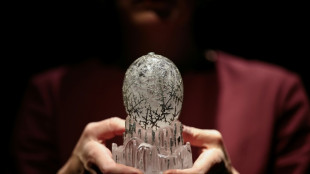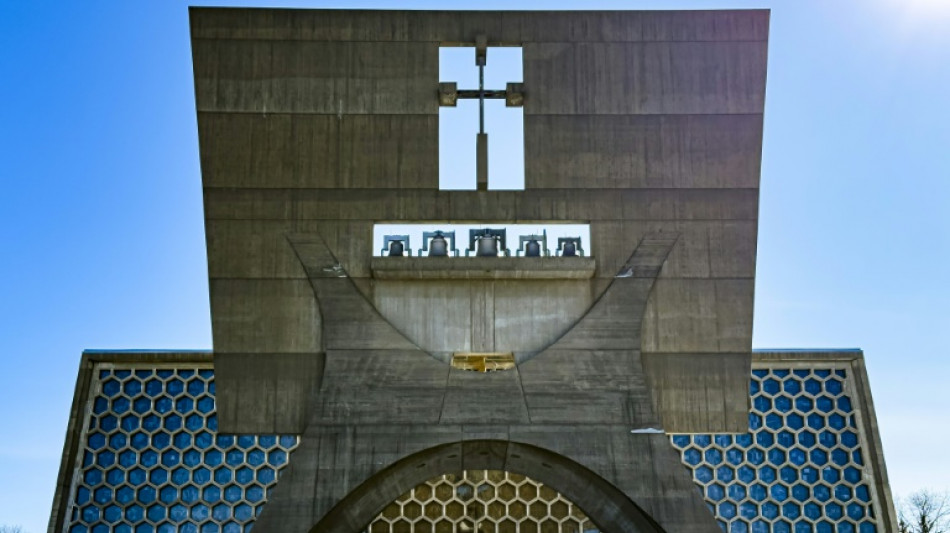
-
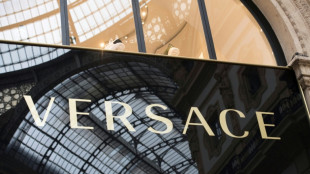 Prada completes acquisition of flashy rival Versace
Prada completes acquisition of flashy rival Versace
-
Asterix in Germany: France's irrepressible Gaul to conquer neighbour
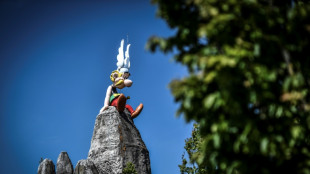
-
 German economy in 'deepest crisis' of post-war era: industry group
German economy in 'deepest crisis' of post-war era: industry group
-
Former England batsman Robin Smith dies aged 62

-
 Afghan Taliban authorities publicly execute man for murder
Afghan Taliban authorities publicly execute man for murder
-
OECD raises US, eurozone growth targets as world economy 'resilient'

-
 'Superhuman' Salah unhappy after being dropped, says Liverpool's Slot
'Superhuman' Salah unhappy after being dropped, says Liverpool's Slot
-
Major sports anti-doping conference opens with call for unity
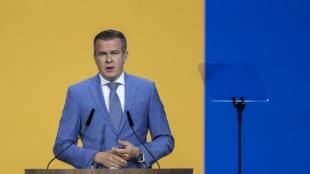
-
 Tens of thousands flock to pope's Beirut mass
Tens of thousands flock to pope's Beirut mass
-
Formula One title showdown: the road to Abu Dhabi

-
 Pope Leo holds Beirut mass, visits port blast site
Pope Leo holds Beirut mass, visits port blast site
-
Hong Kong leader says independent committee to probe fire

-
 How deforestation turbocharged Indonesia's deadly floods
How deforestation turbocharged Indonesia's deadly floods
-
New Zealand 231-9 as 'old school' West Indies exploit pace-friendly wicket

-
 England spinner Jacks replaces injured Wood for second Ashes Test
England spinner Jacks replaces injured Wood for second Ashes Test
-
Pope Leo to hold Beirut mass, visit port blast site

-
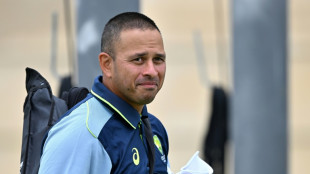 Australia opener Khawaja out of second Ashes Test with injury
Australia opener Khawaja out of second Ashes Test with injury
-
Concern as India orders phone manufacturers to preload govt app

-
 French talent Kroupi 'ready to suffer' to realise Premier League dream
French talent Kroupi 'ready to suffer' to realise Premier League dream
-
New Zealand 231-9 as West Indies exploit bowler-friendly wicket

-
 US Republicans sweat toss-up election in traditional stronghold
US Republicans sweat toss-up election in traditional stronghold
-
'Rescued my soul': Hong Kong firefighters save beloved pets

-
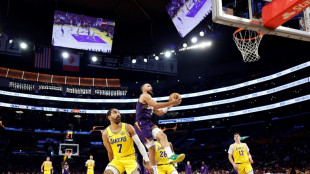 Suns eclipse shoddy Lakers, Mavs upset Nuggets
Suns eclipse shoddy Lakers, Mavs upset Nuggets
-
Seven footballers in Malaysia eligibility scandal 'victims': union

-
 Patriots on brink of playoffs after Giants rout
Patriots on brink of playoffs after Giants rout
-
Survivors, families seek answers to deadly Hong Kong ferry disaster

-
 Race to get aid to Asia flood survivors as toll nears 1,200
Race to get aid to Asia flood survivors as toll nears 1,200
-
Rugby World Cup draw: who, how and when?

-
 Williamson falls for 52 as NZ reach 128-5 in West Indies Test
Williamson falls for 52 as NZ reach 128-5 in West Indies Test
-
Hong Kong leader announces 'independent committee' to probe fire

-
 South Korean leader calls for penalties over e-commerce data leak
South Korean leader calls for penalties over e-commerce data leak
-
Samsung unveils first 'special edition' triple-folding phone

-
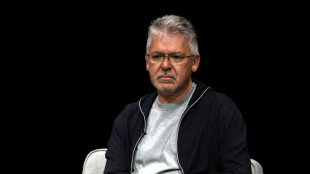 Apple AI chief leaving as iPhone maker plays catch-up
Apple AI chief leaving as iPhone maker plays catch-up
-
Asian markets rise as US rate cut bets temper Japan bond unease

-
 Weight of history against England in pink-ball Gabba Ashes Test
Weight of history against England in pink-ball Gabba Ashes Test
-
How South Korea's brief martial law upended lives

-
 VR headsets take war-scarred children to world away from Gaza
VR headsets take war-scarred children to world away from Gaza
-
'We chose it': PKK fighters cherish life in Iraq's mountains

-
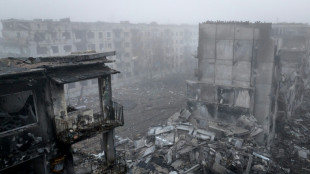 US envoy to meet Russia's Putin for talks on ending Ukraine war
US envoy to meet Russia's Putin for talks on ending Ukraine war
-
Pope Leo holds Beirut mass and visits site of port blast
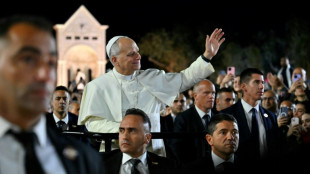
-
 'Quad God' Malinin ramps up Olympic preparations at Grand Prix Final
'Quad God' Malinin ramps up Olympic preparations at Grand Prix Final
-
New Zealand 17-1 at lunch in rain-hit West Indies Test

-
 Pacific island office enabling sanctions-busting 'shadow fleets'
Pacific island office enabling sanctions-busting 'shadow fleets'
-
White House gets scaled-down Christmas display amid ballroom work

-
 GEN Announces New Positive Phase 1 Trial Data of the Investigational Drug SUL-238 for Alzheimer's and Other Neurodegenerative Diseases
GEN Announces New Positive Phase 1 Trial Data of the Investigational Drug SUL-238 for Alzheimer's and Other Neurodegenerative Diseases
-
White House confirms admiral ordered 2nd strike on alleged drug boat

-
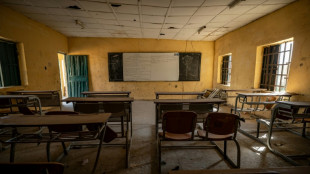 Nigeria's defence minister resigns amid security crisis: presidency
Nigeria's defence minister resigns amid security crisis: presidency
-
From Honduras to Poland, Trump meddles in elections as never before

-
 Trump holds Venezuela meeting as Maduro rejects 'slave's peace'
Trump holds Venezuela meeting as Maduro rejects 'slave's peace'
-
12 dead, dozens missing as landslide submerges boats in Peru port

| GSK | -1.42% | 47.19 | $ | |
| SCS | 0.55% | 16.38 | $ | |
| BCC | -1.18% | 75.13 | $ | |
| NGG | -0.61% | 75.65 | $ | |
| BCE | -0.09% | 23.49 | $ | |
| RBGPF | 1.54% | 79 | $ | |
| BTI | -0.91% | 58.13 | $ | |
| CMSC | -0.39% | 23.32 | $ | |
| RIO | 0.03% | 71.97 | $ | |
| BP | 1.12% | 36.51 | $ | |
| AZN | -2.44% | 90.52 | $ | |
| RYCEF | -2.68% | 13.83 | $ | |
| JRI | -0.15% | 13.78 | $ | |
| RELX | -1.23% | 39.72 | $ | |
| CMSD | -0.13% | 23.29 | $ | |
| VOD | -2.8% | 12.13 | $ |

How a 'forgotten' Minnesota monastery inspired 'The Brutalist'
On a snowy prairie in Minnesota stands a monastery like no other. A concrete trapezoid banner encasing a bell tower looms over a giant, beehive-shaped front window composed of hundreds of gently shimmering hexagons.
For half a century, the existence of this modernist masterpiece has been mainly known to the Benedictine monks who worship there, and the hordes of architects who make pilgrimages to Saint John's Abbey Church each summer.
But these days, it is finding new fame as the basis for "The Brutalist," the epic drama about an immigrant architect, haunted by the Holocaust, that is a favorite to win best picture at the Oscars.
The tale of the church's genesis is as unlikely as the movie plot it inspired, spanning titans of architecture, ambitious monks, Vatican reform -- and an almighty row over that beehive window.
Giving tours to guests, abbey member Alan Reed begins by asking his guests: "How could this have happened?"
"That this small college at the time, in the middle of nowhere, run by a group of monks, would hire a world-famous architect... it is an amazing story," he told AFP.
- 'Extraordinary' -
It begins with Baldwin Dworschak, a 44-year-old "buttoned-down" abbot, who inherited stewardship of a monastery rapidly outgrowing its historic grounds in the post-war US boom years of the 1950s.
At a time when the Catholic Church was reforming and modernizing, Dworschak and his advisors saw an opportunity to emulate the pioneering 12th-century European monks who ushered in the then-new Gothic style.
Arranged by a monk who had studied architecture, letters inviting commissions were sent out to Richard Neutra, Walter Gropius, Eero Saarinen and Marcel Breuer -- among the world's leading modernist architects at the time.
Amazingly, several responded, and Breuer -- a Hungarian Jew who had trained at Germany's influential Bauhaus school, and invented the sleek, tubular-steel chairs that furnish trendy offices to this day -- was appointed to oversee the giant church in a far northern corner of the United States.
The design he came up with was "something nobody had ever seen before," said Victoria Young, a professor of architecture at the University of St Thomas in Minnesota, who wrote a book on Breuer's "extraordinary" creation.
Chinese American architect I.M. Pei -- a former student of Breuer -- once wrote that Saint John's Abbey Church would be considered one of the greatest examples of 20th century architecture if it were located in New York, not Minnesota.
- Almighty row -
Brady Corbet, director of "The Brutalist," cites a book written by Hilary Thimmesh, a junior member of Dworschak's committee, as a key source for his movie.
Corbet told AFP he has visited Saint John's, and stumbled upon Thimmesh's memoir while doing extensive reading for the film.
Several parallels are clear: a Jewish architect designing a colossal Christian edifice on a remote US hilltop, in a controversial modernist style.
A major source of dramatic tension in the film occurs when the client -- a millionaire tycoon in the movie, rather than an abbot -- brings in his own designer, undermining the original architect.
In real life, Breuer struck up a friendship with Dworschak, but they fell out when the monks brought in their own stained-glass window designer, spurning the work of Breuer's close friend and former teacher Joseph Albers.
In a bitter letter, Breuer calls the move a "sudden blow" and states it would be "better to do nothing" than go ahead with the monks' preference.
The new design must be "terminated immediately," says another letter -- to no avail.
The power struggle in "The Brutalist" culminates in a horrific act of sexual violence in an Italian marble quarry.
Thankfully, the real-life client and architect quickly made up.
- 'Forgotten' -
Some inevitable Hollywood hyperbole aside, an Oscar-nominated film bringing attention to their monastery's hidden treasure is a source of pride for those connected to Saint John's.
Architect Robert McCarter wrote a book on Breuer "because I felt Breuer had been forgotten, even by the profession, to some degree," he told AFP.
"There are many people who think that Saint John's is, by far, his greatest building. That includes me," he said.
"It's still a place that enough people don't know about," agreed Young.
For the monks of Saint John's today, the film could offer a more practical lifeline.
The church is badly in need of repairs, with some concrete starting to crumble, and steel beginning to rust.
Their order has shrunk, from being the world's largest male Benedictine monastery with 340 monks, to below 100. It is far too few for such a cavernous space.
"If we could raise enough money," the monks could at least heat the church in winter and cool it in summer, said Reed.
And the attention the film is getting?
"The monks certainly are quite impressed," he said.
S.Leonhard--VB



